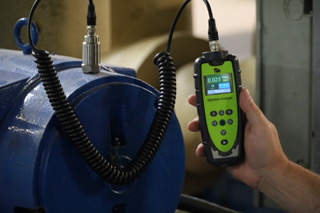
Nowadays it is widely recognised that modern relatively low cost vibration analysers are capable of detecting bearing faults in their early stages. They generally do this by measuring the high frequency bearing noise present in the vibration signal. Allowing the user to trend the bearing noise readings over time, typically via automatic upload to PC based software, enables the user to predict when a bearing will need to be changed.
In days gone by, judging the extent of bearing wearwould have been done by an experienced technician holding a screwdriver to their ear and listening to the tinkling sound of the bearing. The problem was this was highly qualitative, relying heavily on individual experience. Vibration analysershowever, allow thebearing noise to be quantified, giving repeatable measurements.Bearing noise, generally measured as vibration acceleration in units of Earth’s gravity (g), is typically presented in some more meaningful way. A typical example being Bearing Damage Units (BDU), where 100 BDU equates to 1g RMS high frequency vibration. This allows the BDU reading to be considered as an approximate “percentage” of bearing wear. In other words, a reading of 200 BDU indicates the bearing is approx. 200% worn and should be replaced!
However, that is not the end of the story. Whilst we can accurately measure high frequency vibration, in some instances not all of it is due to bearing wear. For example, pump cavitation can produce vibration that looks like bearing noise. Both are of concern of course,but how do we distinguish between them and know when the bearing needs changing? This is where temperature comes in. When a bearing starts to wear out or is in need of lubrication, it usually gets hot. This allows us to be confident that if a bearing is both noisy and hot, then it really is a bearing issue and not cavitation.
Vibration sensors with built-in temperature sensing are nothing new of course, but theseneed to be left on the bearing for a long period of time (at least several minutes) for the temperature reading to stabilise. This poses no problem for permanently installed sensors, butwould be a big issue for portable vibration analysers used as bearing checkers. With its 9085 vibration analyser, Test Products International (TPI) has overcome thislimitation by embedding a platinum resistance temperature sensor (PRT) in the sensor’s magnet mount. This allows the PRT to be in direct contact with the bearing block when the sensor is attached, capturing anearinstantaneous temperature reading while thevibration measurement is carried out.
TPI believes it has madea verysignificant contribution to affordable Condition Based Maintenance (CBM) with this low cost, easy to use, high functionalityvibration analyser/data collector. With its full colour OLED display, instantaneous temperature and vibration measurement, the TPI 9085setsanother benchmark forCBM equipment with high-speed data capture.
The 9085, with wireless battery charging,offers on-meter, easy to decipher CBM analysis for thedetection of unbalance, misalignment, looseness and bearing wear. The inclusion of instantaneous temperature capture means that worn bearings and lubrication issues can be identified beforethey become a problem. With colour-coded alarms and on screen zoom and cursors, the TPI 9085 can store up to 10,000 separate readings,all withtemperature,vibration waveform and frequency spectrum (FFT).
The 9085includes aroute-based mode, where a list of machines can be downloaded for ease of measurementpoint identification and data collectionusingthe includedFREE, Subscription FREE, C-Trend PC software.C-Trend’s basic functions such as vibration and temperature trending and alarm reporting are totally intuitive, ensuring the software can very easilybe usedby both novice andexpert users to implement an effective CBM strategy.
For more information, please contact TPI Europeon +44 1293 530196 orwww.tpieurope.com or email This email address is being protected from spambots. You need JavaScript enabled to view it.
This article can also be found in the issue below.



